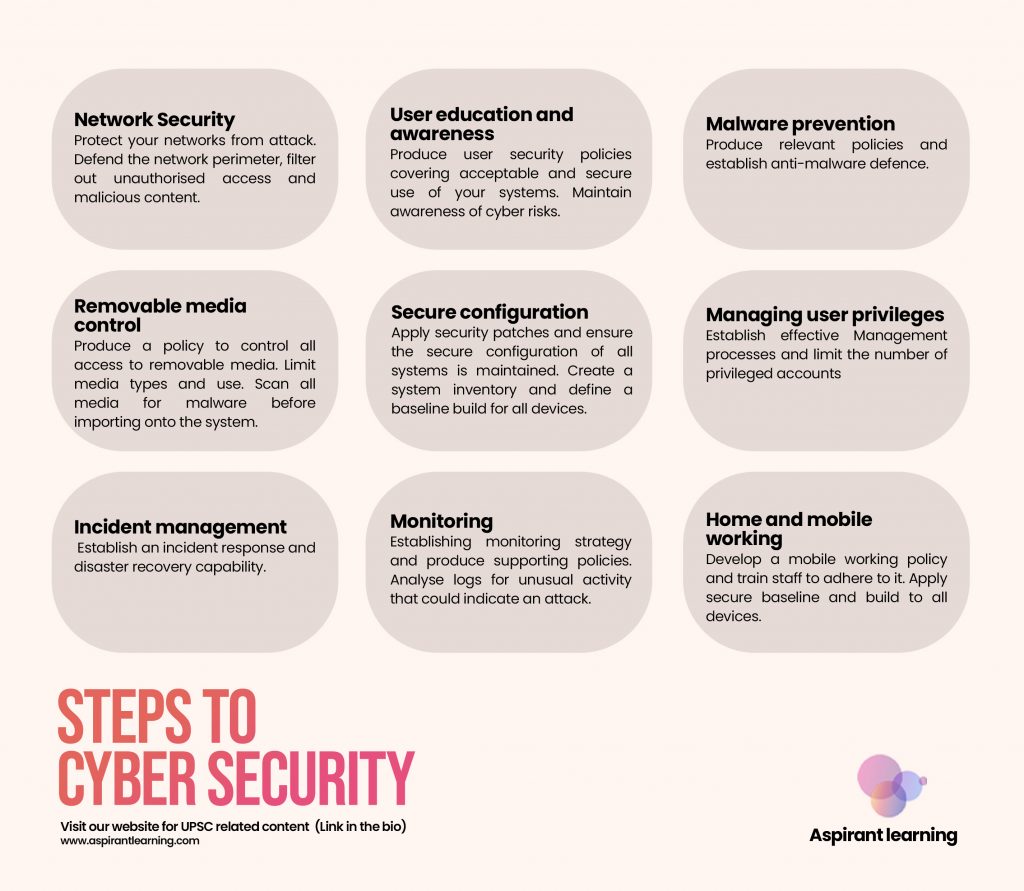News Highlight
Draft cyber security strategy has been formulated: Centre
Key Takeaway
- The National Security Council Secretariat (NSCS) has formulated a draft National Cyber Security Strategy.
- The Indian Computer Emergency Response Team (CERT-In) issues alerts and advisories regarding the latest cyber threat and countermeasures to protect computers and networks on an ongoing basis.
National Security Council Secretariat (NSCS)
- NSCS is India’s apex agency in charge of the country’s political, economic, energy, and strategic security concerns.
- The National Cyber Security Coordinator (NCSC) reports to the NSCS and coordinates cyber security matters at the national level with various agencies.
National Cyber Security Strategy (NCSS)
- The Data Security Council of India (DSCI) created the report, focusing on 21 areas to ensure India has a safe, secure, trusted, resilient, and vibrant cyberspace.
- The following are the report’s primary focus areas.
- Supply chain security: Monitoring and mapping of the supply chain of the Integrated circuits (ICT) and electronics products.
- Digital payments: Device and platform deployment mapping and modelling, regular threat modelling exercises.
- It is to reveal vulnerabilities, threat research and intelligence sharing, and prompt vulnerability disclosure.
- Creating state-level cybersecurity policies, allocating funds specifically for that purpose, and examining digitisation plans critically.
- Hence, establishing standards for security architecture, operations, and governance.
Need for a National Cyber Security Strategy
- Increase In Recent Cyber Attacks
- Cyber attacks are growing and becoming more disruptive to businesses overnight.
- It’s only going from bad to worse with threat actors finding new attack methods.
- This year, we have covered several recent cyberattacks, including
- Cisco Cyber Attack
- Twitter Zero-Day
- Starlink Dish Hacked,
- Largest European DDoS Attack
- Cloudflare & Twilio Attack
- Mantis Botnet
- Maui Ransomware Attack
- Conti Ransomware Attack
- Despite security safeguards, 89% of healthcare firms have also experienced a data breach in the last two years.
- Increased Digital usage Post-Covid
- Critical infrastructure, such as financial services, banks, power, manufacturing, nuclear power plants, etc., is rapidly becoming digitalised.
- For government and individuals
- A municipal, state or federal government keeps sensitive information on the nation (geographic, military-strategic assets, etc.) and its people.
- On social networking websites, people can share pictures, videos, and other private information that can be misused by others and result in dangerous, even fatal, situations.

8 Steps To Creating A Cyber Security Plan
- Conduct A Security Risk Assessment
- Set Your Security Goals
- Evaluate Your Technology
- Select A Security Framework
- Review Security Policies
- Create A Risk Management Plan
- Implement Your Security Strategy
- Evaluate Your Security Strategy
Conclusion
- The most critical factors for cybersecurity are visibility, mitigation, prioritising, and encryption.
- For organisations, it can entail protecting themselves against financial crimes like employee theft or customers accessing company accounts without authorisation and committing identity theft.
Pic Courtesy: The Hindu
Content Source: The Hindu



